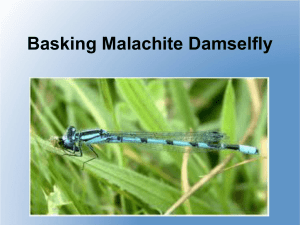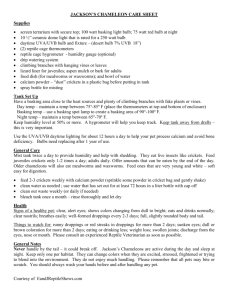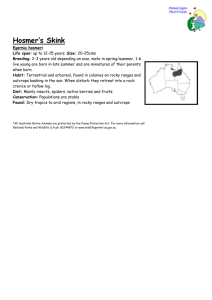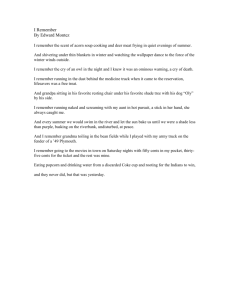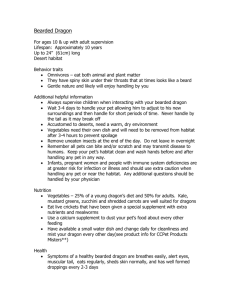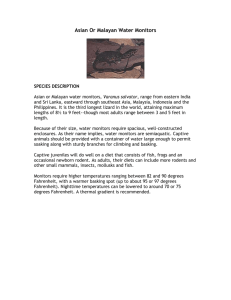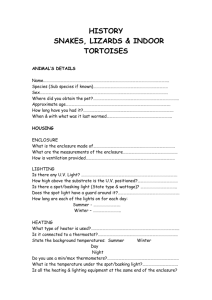2 IRCF ReptIles & AmphIbIAns • Vol 18, no 1 • mAR 2011 CARR, holComb, AnD RAY Macrochelys temminckii
advertisement
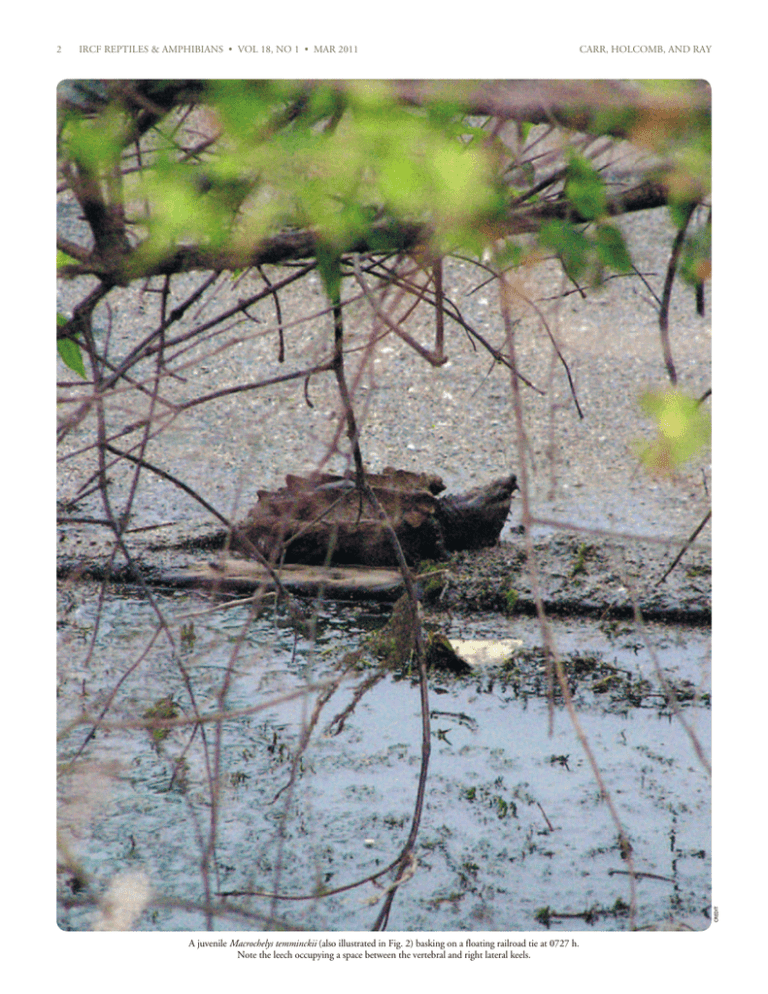
IRCF Reptiles & Amphibians • Vol 18, No 1 • MAR 2011 carr, HOLCOMB, and ray Credit 2 A juvenile Macrochelys temminckii (also illustrated in Fig. 2) basking on a floating railroad tie at 0727 h. Note the leech occupying a space between the vertebral and right lateral keels. Alligator Snapping Turtles IRCF Reptiles & Amphibians • Vol 18, No 1 • MAR 2011 3 Basking in the Alligator Snapping Turtle, Macrochelys temminckii (Testudines: Chelydridae) John L. Carr1, Samuel R. Holcomb1,2, and Mitchell J. Ray1,3 1 Department of Biology and Museum of Natural History, University of Louisiana at Monroe Monroe, Louisiana 71209, USA (carr@ulm.edu) 2 Louisiana Department of Wildlife and Fisheries, P.O. Box 98000, Baton Rouge, Louisiana 70898, USA (samsw1@aol.com) 3 3321 Bluebird Ridge, New Braunfels, Texas 78130, USA (mitchray.ray@gmail.com) Photographs by the senior author. M acrochelys temminckii is the largest freshwater turtle in North America, and is often considered one of the most aquatic species as well (Pritchard 1967). Only adult females are known to regularly leave the water, and then only to nest (Ernst and Barbour 1972, Zappalorti 1976, Pritchard 1989). Basking in this species was long thought to be non-existent or extremely rare (Brattstrom and Collins 1972, Ernst and Barbour 1972). Although some authors have suggested that aquatic basking occurs in this species (Zappalorti 1976, Howey and Dinkelacker 2009), no published reports describe such behavior. However, several publications describe aerial basking in M. temminckii, but each literature report consists of a single observation (Ewert 1976, Shelby and Jensen 2002, Farr et al. 2005, Selman et al. 2009, Thomas 2009, Selman and Willig 2010). Of the six reported instances of basking, one was a hatchling (42 mm, Shelby and Jensen 2002), three were juveniles (~100–200 mm CL; Ewert 1976, Thomas 2009, Selman and Willig 2010), and two were of adult sizes (~350–400 mm, Farr et al 2005; ~400–500 mm, Selman et al. 2009). One instance of basking was inferred from capturing a specimen in a basking trap (Shelby and Jensen 2002). In the other five cases in which basking was actually observed, three of the turtles appeared to have been basking for some time, as the animals were described as dry (Ewert 1976, Farr et al. 2005, Thomas 2009), but the maximum reported observation period lasted no longer than about 12 min (Farr et al. 2005). All six observations were associated with lotic habitats (creeks or rivers), with basking substrates including a fallen tree trunk, snags, and river banks. Where reported, turtles were resting on the basking substrate inclined at angles estimated at 30–60°, with the head pointed upslope (Ewert 1976, Farr et al. 2005, Selman et al. 2009). In one case, the animal’s resting angle was not noted, but the snag to ascend to the basking spot was nearly vertical (90°) and involved climbing over an intervening obstacle (Selman and Willig 2010). The five recorded times for basking behavior were between 1000 and 1700 h. During the 2009 field season, we observed two instances of aerial basking and one of aquatic basking, all involving juvenile M. temminckii. Observations were made at Black Bayou Lake National Wildlife Refuge, 11.5 km north of Monroe in Ouachita Parish, Louisiana. The centerpiece of the refuge is a large lake (~845 ha), which is a back swamp (Wang 1950) that has been dammed by a railroad line, and now has the water level controlled with a stop-log structure. Air temperatures were obtained from the nearest station in Ouachita Parish for the appropriate date and time (Weather Underground, http://www.wunderground.com). While radio-tracking on Black Bayou Lake at approximately 1400 h on 9 March 2009, a juvenile M. temminckii (carapace length [CL] = 174.3 mm, weight = 1.04 kg) was observed with its head exposed above the water. The afternoon was sunny, with very little cloud cover. Upon closer inspection, the turtle was found to be floating above a bed of submerged aquatic vegetation composed primarily of Egeria densa (Brazilian Waterweed) and Ceratophyllum demersum (Coontail). The head and keels of the carapace were exposed above the water, where it remained for a period of ~5 min, with no indication that it was foraging. The turtle was captured by hand and brought to the lab for examination. It was identified by a PIT tag as a “head-started” juvenile from the 2004 year-class that we released on 12 June 2008. Water temperature at the time of capture was 21 °C and air temperature was approximately 27 °C. This observation matches well the Fig. 1. Juvenile Macrochelys temminckii (A) basking on the end of a railroad tie in the shade of a Water Elm (Planera aquatica). The same individual (B) immediately after capture. Note the large leech attached to the carapace. 4 IRCF Reptiles & Amphibians • Vol 18, No 1 • MAR 2011 description of aquatic basking by Moll and Legler (1971). They described aquatic basking as behavior in which “turtles ... were motionless at the surface with limbs fully extended and part of the carapace out of the water,” and went on to say that the most common sites for aquatic basking of Panamanian Sliders (Trachemys venusta) “were over beds of [a submerged aquatic plant] or near other mats of vegetation.” In the course of terrestrial nesting surveys along the railroad causeway in the northwestern corner of the lake, we observed a juvenile (CL = 190.2 mm, weight = 1.52 kg) on 20 April 2009 at 0900 h. It was resting on an old railroad tie among riprap at the margin of the lake, 29 cm above ground level. The wet turtle was sitting askew on the bank end of the railroad tie with a large leech on the right side of its carapace (Fig. 1). The railroad tie was inclined at ~12° into the water from the bank. Based on the animal’s position and the wet trail it left on the tie, the turtle had to have climbed the bank and then the end of the railroad tie (~80–90°) to reach its location atop the high, out-of-water end. The turtle was positioned in such a way that it was resting at an angle near horizontal. The left hind leg was dangling in the air, but the right-side limbs were extended and in contact with the substrate; the head and neck were also extended and resting on the wood. The digits were not maximally abducted (spread apart). This turtle was observed for just a few minutes before being captured. When approached, the animal quickly dove into the water on the lake-side of the railroad tie. At the time of this observation conditions were clear and sunny, although the basking site was fully shaded by a small Water Elm (Planera aquatica). Air temperature at the time of capture was approximately 17 °C. We found another basking M. temminckii during a terrestrial nesting survey along the lake margin on 29 April 2009. At 0720 h, a juvenile (cara- carr, HOLCOMB, and ray pace length ~140 mm) was observed on a railroad tie floating ~3 m from the shoreline (Fig. 2). As can be seen in the photograph, the tail extends straight behind the body, the right hind leg is minimally extended without abducted digits, the right forelimb is more fully extended, and all are in contact with the substrate. The head and neck are fully extended and the animal appears alert, possibly with the proximal portion of the neck resting on the substrate. The weathered railroad tie was horizontal, providing a 0° basking surface, and was located in the early morning shadows, not exposed to the sun. A leech was noted on the carapace, and the turtle was photographed and observed until 0730 h, at which time the observer (JLC) left the site. At approximately 0807 h, when the observer returned to the basking site, the individual was seen in the same position, and the carapace was drier, indicating that basking had continued in the meantime. In addition, the leech that had been observed on the carapace moved until it was out of sight (Fig. 2 insert), which fits with the idea that the drying of a turtle during basking would tend to cause leeches to release their hold (Pope 1939, Cagle 1950). The empty puparium and a newly emerged adult damselfly (Odonata: Zygoptera) are also visible in one of our photos, so the turtle had remained in the same position long enough to serve as a substrate for emergence by this aquatic insect. The first to last observations of this individual spanned 58 min. Air temperature was approximately 22 °C. Our observations include the first specific instance of aquatic basking reported for the species, and two additional instances of aerial basking. Obbard and Brooks (1979) noted a preponderance of aerial basking in Chelydra, but the incidence of aquatic basking was as high as 16% of all basking observations for radio-telemetered individuals in their population. These are the only observations of basking M. temminckii that we have Fig. 2. A second juvenile Macrochelys temminckii basking on a floating railroad tie. Note that the leech is moving across the vertebral keel at 0816 h. In the insert, the leech is no longer visible on the carapace at 0817 h. Alligator Snapping Turtles IRCF Reptiles & Amphibians • Vol 18, No 1 • MAR 2011 5 made during 15 years of field work at this site by the senior author (1996– 2010), so we are inclined to agree with the notion that basking occurs only rarely in this species (Ewert 1976). Obbard and Brooks (1979) noted among the reasons that basking might have been infrequently reported in Chelydra serpentina prior to their study was that individuals almost always bask alone on a particular object, as opposed to emydids, which are frequently found in large numbers on the same object or even stacked on one another. All reports of aerial basking Macrochelys are of single individuals, thus if the animals are wary, an individual could very easily slip into the water unnoticed. In addition, with respect to M. temminckii, the dark coloration of the carapace and soft parts would tend to be well camouflaged on most logs or other woody structures, and the rough texture of the shell and soft parts would tend to disrupt the outline of the turtle, both of which would complicate seeing an individual before it slipped into the water. All reports of aerial basking in M. temminckii involve single individuals on a bank or wood substrate. In C. serpentina (its closest North American relative), Obbard and Brooks (1979) reported that 99% of 233 aerial basking observations involved a single turtle on a basking object. The posture assumed by the two aerial basking M. temminckii that we observed was similar to what Ewert (1976) described for Chelydra, in which the feet remain in contact with the basking object, rather than being fully extended in mid-air with the digits maximally abducted as is commonly seen with the hind limbs in emydids (Cagle 1950, Auth 1975). Obbard and Brooks (1979) reported seeing limbs extended with the webbing spread in Chelydra, but they did not quantify the incidence of the behavior; however, in their photo, the left hindlimb is not elevated above the substrate with the digits maximally abducted. Obbard and Brooks (1979) also noted that only about 5% of their Chelydra basking observations involved an on-shore basking substrate. With respect to Macrochelys, four of the aerial basking observations have involved basking substrates on the bank or a log attached to the bank, and four involved free-floating or fixed offshore objects. With a total of nine basking observations for the species now, comparison with factors related to the appearance of the behavior may start to be made. Some explanations for basking are applicable only to adult turtles. Of the nine known instances of basking in M. temminckii, the majority of individuals were juveniles (7 of 9, including our 3 observations), so any association with maturation of ovarian follicles in females or warming by basking in the spring to enhance mating behavior (Obbard and Brooks 1979) could account for no more than a small fraction of the reported cases. A number of general explanations for basking behavior are available, including thermoregulation (Boyer 1965, Moll and Legler 1971, Obbard and Brooks 1979), vitamin-D synthesis (Pritchard and Greenhood 1968), drying of the skin and shell surface that could reduce ectoparasite and epizoophyte load (Pope 1939, Cagle 1950, Boyer 1965, Shelby and Jensen 2002), and as a response to illness or injury (Selman and Qualls 2009). The case of aquatic basking would seem clearly related to thermoregulation since it was exposed to full midday sunlight and is the earliest spring date recorded for basking when water temperatures were relatively low. Our other two observations both involved turtles in the shade, Ewert’s (1976) observation was under a lightly overcast sky, and Thomas (2009) reported the individual he saw was in partial sunlight. Although most individuals that have been observed were exposed to sunny skies as one would expect of a turtle basking for thermoregulation, indirect ultraviolet light associated with vitamin-D synthesis could still reach a turtle under a cloudy sky or in the shade, but much less effectively than exposure to direct sunlight. Both of the aerial basking individuals we observed had large leeches on the carapace, and for one of the two, we were able to document that the leech released its initial hold and moved over time as the turtle’s shell dried. This was similar to observations of Graptemys by Selman et al. (2008) and Selman and Qualls (2009); however, Thomas (2009) noted 100+ leeches were still attached to the juvenile he captured while basking. Acknowledgments This research was performed under Louisiana State Scientific Collecting Permit LNHP–09–059 and U.S. Fish and Wildlife Service Special Use Permit 42651–09–03. Funding was provided by the Louisiana Department of Wildlife and Fisheries and the U.S. Fish and Wildlife Service, Division of Federal Aid, through the State Wildlife Grants Program. Headstarting was undertaken by the Natchitoches National Fish Hatchery. We would like to thank the staff of Black Bayou Lake National Wildlife Refuge, and Karen Kilpatrick at the Natchitoches National Fish Hatchery for their cooperation. We thank D. Ligon for helpful comments on the manuscript. Literature Cited Auth, D.L. 1975. Behavioral ecology of basking in the Yellow-bellied Turtle, Chrysemys scripta scripta (Schoepff). Bulletin of the Florida State Museum, Biological Sciences 20:1–45. Boyer, D.R. 1965. Ecology of the basking habit in turtles. Ecology 46:99–118. Brattstrom, B.H. and R. Collins. 1972. Thermoregulation. International Turtle and Tortoise Society Journal 6(5):15–19. Cagle, F.R. 1950. The life history of the Slider Turtle, Pseudemys scripta troostii (Holbrook). Ecological Monographs 20:31–54. Ernst, C.H. and R.W. Barbour. 1972. Turtles of the United States. University Press of Kentucky, Lexington. Ewert, M.A. 1976. Nests, nesting and aerial basking of Macroclemys under natural conditions, and comparisons with Chelydra (Testudines: Chelydridae). Herpetologica 32:150–156. Farr, W., P. Crump, and J. Caraviotis. 2005. Macrochelys temminckii (Alligator Snapping Turtle). Aerial basking. Herpetological Review 36:168. Howey, C.A.F. and S.A. Dinkelacker. 2009. Habitat selection of the Alligator Snapping Turtle (Macrochelys temminckii) in Arkansas. Journal of Herpetology 43:589–596. Moll, E.O. and J.M. Legler. 1971. The life history of a Neotropical slider turtle, Pseudemys scripta (Schoepff), in Panama. Bulletin of the Los Angeles County Museum of Natural History, Science (11):1–102. Obbard, M.E. and R.J. Brooks. 1979. Factors affecting basking in a northern population of the Common Snapping Turtle, Chelydra serpentina. Canadian Journal of Zoology 57:435–440. Pope, C.H. 1939. Turtles of the United States and Canada. Alfred A. Knopf, New York. Pritchard, P.C.H. 1967. Living Turtles of the World. T.F.H. Publications, Jersey City, New Jersey. Pritchard, P.C.H. 1989. The Alligator Snapping Turtle: Biology and Conservation. Milwaukee Public Museum, Milwaukee, Wisconsin. Pritchard, P.C.H. and W.F. Greenhood. 1968. The sun and the turtle. International Turtle and Tortoise Society Journal 2:20–25. Selman, W., B. Drescher, and C. Qualls. 2009. Macrochelys temminckii (Alligator Snapping Turtle). Adult basking behavior. Herpetological Review 40:79. Selman, W. and C. Qualls. 2009. Graptemys flavimaculata (Yellow-blotched Map Turtle). Basking and parasite removal. Herpetological Review 40:78–79. Selman, W., D. Strong, and C. Qualls. 2008. Graptemys gibbonsi (Pascagoula Map Turtle). Basking and parasite removal. Herpetological Review 39:216. Selman, W. and M. Willig. 2010. Macrochelys temminckii (Alligator Snapping Turtle). Aerial basking and climbing ability. Herpetological Review 41:486. Shelby, J.A. and J.B. Jensen. 2002. Macrochelys temminckii (Alligator Snapping Turtle). Aerial basking. Herpetological Review 33:304. Thomas, T.M. 2009. Macrochelys temminckii (Alligator Snapping Turtle). Aerial basking. Herpetological Review 40:336. Wang, K. 1952. Geology of Ouachita Parish. Geological Bulletin (28):126. Zappalorti, R.T. 1976. The Amateur Zoologist’s Guide to Turtles and Crocodilians. Stackpole Books, Harrisburg, Pennsylvania.
